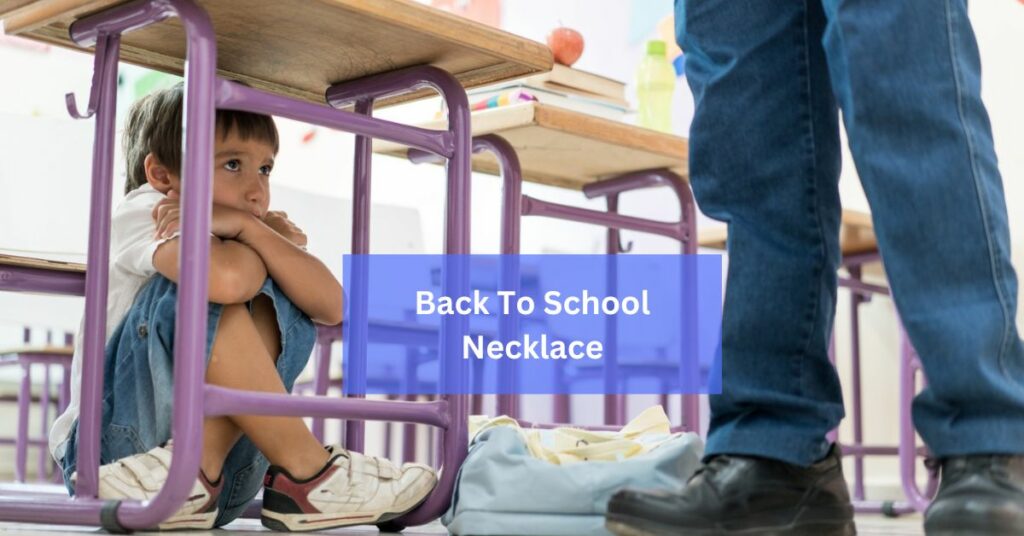Back To School Necklace – Exploring Its Meaning!

The period leading up to the new school year is often filled with anticipation and excitement for students and parents alike. However, amidst the flurry of back-to-school preparations, there exists a disturbing trend known as the “back to school necklace.”
The phrase “back to school necklace” is used to talk about a noose, which is a dangerous thing used for hanging oneself. It’s a scary term that has become popular online, especially among young people.
In this article, we’ll Learn how to recognize warning signs and support those affected by this alarming phenomenon.
Origins And Spread Of The Term – Find Out How This Worrying Trend Has Spread Across The Internet!
The exact start of the term “back to school necklace” isn’t totally clear, as it slowly appeared online among young people. It became more popular through social media and websites where slang words and jokes spread quickly.
Though we can’t pinpoint exactly how it started, it likely began as a dark joke or way for kids to talk about the stress of going back to school. Some students might have used it to express feeling overwhelmed by schoolwork, friends, or other problems.
Urban Dictionary, a website where people explain slang words, has an entry for “back to school necklace.” It says it’s another way to say “noose” because of the sadness some feel when school starts again.
This entry probably helped the term become more widespread, giving people a place to talk about it and share what they think it means.
As more people started using the term online, it showed up on social media a lot. People posted memes, hashtags, and talked about it in comments.
They often used pictures of nooses and talked about feeling sad or stressed about school, but sometimes they used humor to talk about it too.
The “back to school necklace” trend spread because people talked about it secretly, using words that didn’t make it obvious what they were really talking about. This way, they could discuss serious topics without getting in trouble or attracting too much attention.
Even though we don’t know exactly where it came from, the “back to school necklace” trend has made people think more about mental health and how hard it can be for young people.
It’s brought up important conversations about how to help kids who might be feeling sad or stressed.
Impact And Concerns – Take Action Now To Prioritize The Well-Being Of Our Youth!

The “back to school necklace” trend is causing worries about how it affects young people’s feelings and behavior. Here are some important things to understand about its impact:
1. Talking About Suicide Like It’s Normal:
When people use the phrase “back to school necklace” to mean suicide by hanging, it makes talking about suicide seem normal. But suicide is serious, and talking about it casually can make it seem like it’s not a big deal.
2. Making Mental Health Issues Seem Worse:
The “back to school necklace” trend can make people think that having mental health issues, like feeling sad or hopeless, is something to joke about. But it’s not funny, and it can make it harder for people to get help when they need it.
3. Making It Harder to Spot Signs of Trouble:
Because the “back to school necklace” trend is sneaky, it can be tough to tell if someone is feeling really sad or thinking about hurting themselves. This makes it harder for friends, family, and teachers to notice when someone might need help.
4. Making Young People Feel More Stressed:
Teenagers already have a lot to deal with, like school, friends, and growing up. The “back to school necklace” trend can add extra stress by making it seem like everyone else is dealing with the same tough feelings.
Recognizing Warning Signs – Take The First Step Towards Healing!

Recognizing warning signs of mental distress and suicidal ideation is crucial for early intervention and support. Here are some indicators to watch for:
1. Changes in Behavior: Pay attention to any significant changes in behavior, such as withdrawal from social activities, avoidance of previously enjoyed hobbies, or increased irritability and agitation.
2. Mood Swings: Fluctuations in mood, including sudden bouts of sadness, hopelessness, or unexplained anger, may signal underlying emotional distress.
3. Social Withdrawal: If an individual begins to isolate themselves from friends and family, avoiding social interactions or withdrawing from previously close relationships, it could be a sign of internal struggles.
4. Expressions of Hopelessness: Listen for expressions of hopelessness or despair, whether overt or subtle. Statements like “I feel like giving up” or “I don’t see the point anymore” may indicate suicidal ideation.
5. Changes in Sleep or Eating Patterns: Significant changes in sleep or eating habits, such as insomnia or excessive sleeping, loss of appetite or overeating, may be indicative of emotional distress.
6. Self-Harm Behaviors: Look for signs of self-harm, such as unexplained injuries, frequent accidents, or wearing long sleeves in warm weather to conceal marks or scars.
7. Giving Away Possessions: Some individuals contemplating suicide may give away cherished belongings or make statements indicating they no longer need certain items.
8. Increased Substance Use: Escaping through alcohol or drug use can be a sign of underlying mental health issues. Keep an eye out for changes in substance use patterns.
9. Sudden Improvement: Paradoxically, a sudden improvement in mood or demeanor after a period of depression may indicate that an individual has made the decision to end their life.
10. Previous Suicide Attempts: Individuals who have previously attempted suicide are at higher risk for future attempts and should be closely monitored for signs of relapse.
Addressing The Issue:
The increase in the “back to school necklace” trend shows we need to do more to help students with their feelings and stop suicide.
Schools can set up ways to support mental health, like talking to counselors, joining groups with peers for help, and teaching everyone about mental health. Also, groups in the community and people who help with mental health are important for giving kids the right help they need.
Frequently Asked Questions:
1. Is the “back to school necklace” trend limited to a specific region or demographic?
The trend has gained traction online and may be observed across various social media platforms and online communities. While its prevalence may vary, discussions surrounding mental health and suicide prevention are relevant to individuals of all ages and backgrounds.
2. How can parents initiate conversations about mental health with their children?
Parents can create opportunities for open dialogue by expressing empathy, actively listening to their child’s concerns, and validating their emotions. It’s essential to approach discussions about mental health with sensitivity and without judgment, providing a safe space for children to share their thoughts and feelings.
3. Are there resources available for individuals struggling with suicidal thoughts?
Yes, there are numerous resources available for individuals experiencing suicidal ideation or mental health challenges. Crisis hotlines, online support groups, and mental health organizations offer confidential assistance and guidance. Additionally, seeking help from a licensed therapist or mental health professional can provide personalized support and treatment options.
Conclusion:
The appearance of the “back to school necklace” trend shows how youth culture, mental health, and social media are connected. We can make things better by talking openly, learning about mental health, and helping those who need it.
Let’s work together to stop the stigma around mental illness and make sure young people feel safe and supported. We must understand when someone is upset, be kind, and focus on keeping our young people healthy and happy.
Read:







